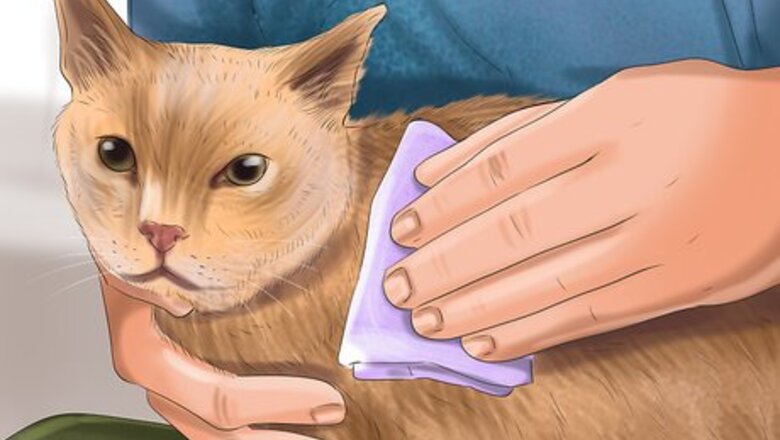
views
Taking Initial Action

Deal with any bleeding right away. Immediately see if your cat is bleeding. When it comes from a dog, even a small bite can cause bleeding. Apply direct pressure to the wound. You need to do this with sterile gauze. Gauze from a human first aid kit should be safe for your cat. If you do not have a first aid kit, you can use large bandages, which should be sterile. Do not use anything that could cause an infection, especially tissue paper or toilet paper left out in the bathroom, as this can be ripe with bacteria. It may take 5 or 10 minutes for the bleeding to stop. Your cat will probably be frightened and cats, by nature, will instinctively run and hide when scared. You may need the assistance of a second person to hold your cat still and you might also want to wrap your cat in a blanket to prevent him from kicking and scratching. If possible, tape the gauze or bandaid in place once bleeding stops. Removing it may remove the blood clot, resulting in your cat starting to bleed again.

Examine the cat for other wounds. Even if only one spot on your cat is obviously bleeding, do a thorough examination to check for any other wounds on your cat's body. Dog bites and scratches can cause a variety of marks. Your cat may have minor breaks in the skin, puncture wounds, or scratches. These might not be bleeding at all or only bleeding a small amount but they still warrant treatment via cleaning.

Clean the wound to the best of your abilities. Once you've treated any bleeding and examined your cat for other wounds, you should clean the wounds quickly. It's best to use an antiseptic solution, but if this is unavailable simply use plain water. You can create an antiseptic solution by diluting concentrated solutions containing iodine or chlorhexidine diacetate in water. Such solutions can be purchased at most drug stores and should be diluted to the point they're the color of tea or a light blue shade. Avoid disinfectants that contain phenolic compounds, alcohol, or hydrogen peroxide as these are toxic to cats. If in doubt, make up a salt water solution by adding a teaspoon of salt to a pint of previously boiled water. Allow it to cool before you use it. Flush the solution over the surface of the wound. If possible, use a syringe to do so. If the wound is long or deep, or a puncture wound, clean around the edges instead of inside the wound itself.

Learn about potential complications. Left untreated, dog bites can result in a number of potential complications. They can become infected and lead to other symptoms. An untreated bite can develop into an abscess, which is a fluid filled lump just under the surface of the skin. You may notice your cat limping as well as a loss of appetite or lethargy. Hair might fall out around the bite and skin might become red, ooze, and emit a foul odor. If your cat has not had a recent rabies vaccination, he should be vaccinated right away if you do not know the dog's rabies status. You may have to have your cat quarantined and observed for signs of rabies.
Seeking Veterinary Care
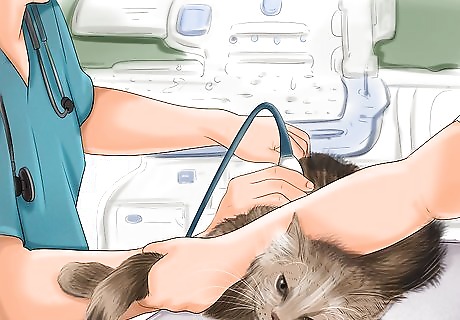
Get an appointment as soon as possible. Even if wounds seem minor, any injuries should be treated by a veterinarian immediately. Dog saliva could potentially cause infections and if there's need for further treatment beyond at home care, it's better to know sooner than later. In addition to taking normal vitals like heartbeat and temperature, your veterinarian will perform a thorough examination of any and all wounds to determine the best course of treatment. Your cat's hair will likely be shaved in certain areas near the wounds prior to the physical examination. X-rays may be needed for certain wound depending on how deep or severe they are. If your cat is still shaken up from the fight, he may behave aggressively in the vet's office. Sedation may be needed. If you're seeing a new vet, make sure to give her a brief listing of your cat's medical history. Certain conditions, like heart murmurs, can be affected negatively by sedation.

Go over treatment options. Treatment is dependent on the severity of the cut. Your vet will choose a treatment option that's right for your cat. Small wounds may not require much care. Your vet will clean such wounds and might use some skin glue to keep the edges together. However, deeper wounds will be cleaned carefully and if they're less than 12 hours old they will be sutured together. If wounds are contaminated, or very long and deep, they may require the placement of a Penrose drain. This is a soft rubber tube that drains contamination from a wound.
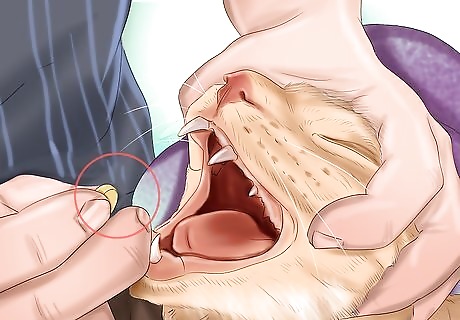
Ask for instructions regarding any medication. Medication may be required. Depending on whether the wound is infected, antibiotics might be needed. Your cat might also just need painkillers to deal with discomfort. Make sure you understand how and when to administer whatever medication is prescribed and ask your vet questions about possible side effects. Normally, your vet will prescribe a round of antibiotics for your cat. Give the cat all the meds as directed. Even if symptoms clear up, continue administering antibiotics until they're gone.
Caring for your Cat at Home
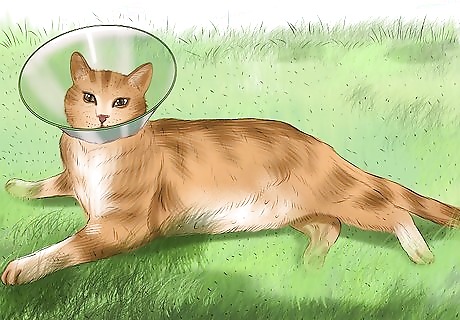
Keep your cat from licking his wound. You need to make sure your cat does not lick or bite at his wound. This could cause an infection or prematurely open bandages, drains, or sutures. You might need to ask your vet about a Elizabethan collar, which is a cone like device attached to your cat's neck to prevent licking. Depending on your cat's temperament, he may be able to tolerate an Elizabethan collar. If you notice your cat licking or chewing, gently correct the behavior. Clap your hands and say "No." You may have to ask someone to watch your cat while you're at work or school to make sure he does not chew at his wounds.
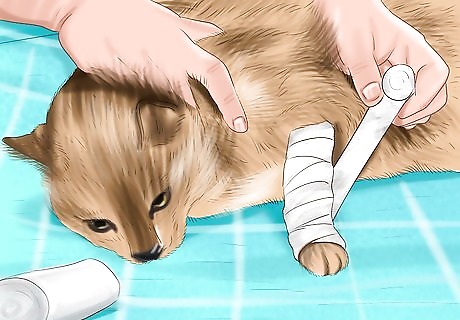
Change bandages as directed. Your vet will give you directions about changing your cat's bandages. Follow her instructions and call her with any questions. You may need to change bandages as often as two to three times a day. If you have a busy schedule, ask a friend or family member who's comfortable with cats whether they can change the bandages while you're at work or school. You might have to place antibiotic ointment around the wounds while changing the bandages, depending on the care regimen your vet outlined. If you notice an odor or unusual discharge while changing the bandages, take your cat to the vet's for reevaluation.
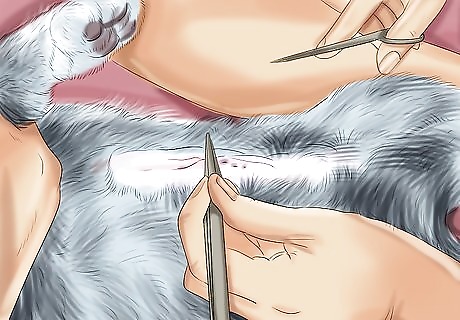
Make all necessary follow up appointments. If your cat was given sutures or a drain, you'll need to make a follow up appointment to have them removed. Sutures are usually removed 10 to 12 days after being put in place. Penrose drains are generally removed in 3 to 5 days.

Prevent such accidents in the future. You want to make sure such accidents do not happen in the future. Dog bites can be fatal. If the bite was caused by a neighborhood dog, talk to your neighbor about making sure it does not happen again. Ask him politely not to let his dog run loose and suggest obedience training to deal with aggression issues. In general, do not let your cat run loose unsupervised in your neighborhood. This can prevent him from encountering another dog in the future. If the incident happened with your own dog, you need to separate the animals until they've both calmed down and then slowly reintroduce them. Allow them to interact through a door at first and then have short, supervised face-to-face interactions.

















Comments
0 comment